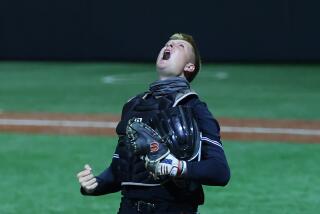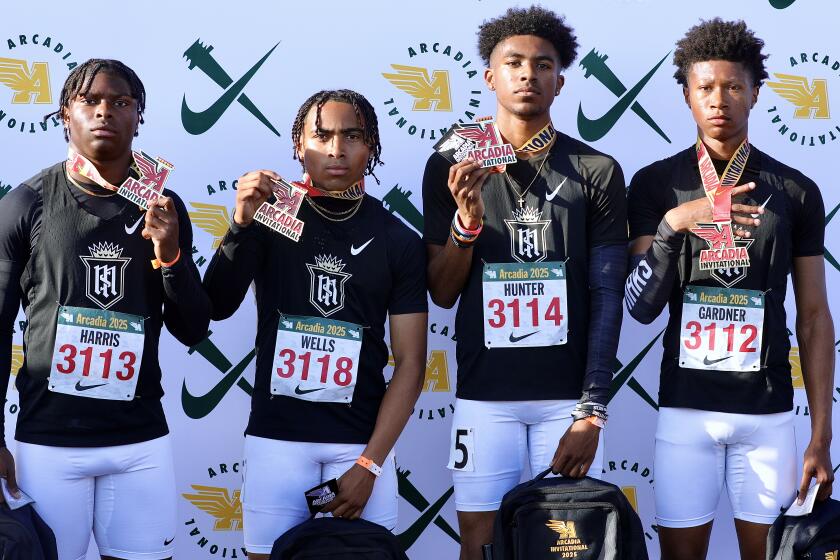Camp Fire Is Fueled by Competition : Basketball: High school players from San Diego find that the going gets tougher when they travel north to camp out against talent from the Los Angeles area.
- Share via
POMONA — The same distinguished-looking, gray-haired man who recruited Jud Buechler, Kevin Flanagan and now Tony Clark away from San Diego was at it again last week. This year, Lute Olson, University of Arizona basketball coach, has his eye on Rancho Buena Vista senior Darryl Parker.
Olson was here attempting to get a read on Parker, a 6-foot-6 forward, and other high school basketball players at the West Coast Invitational All-Star Camp at Cal Poly Pomona.
For Olson and most of the 200 or so college coaches who will visit this five-day camp, it is the only time of year they will see Parker against quality competition. During Parker’s high school season, it will become harder to project how he would do as a Division I player.
Most of the time, he will play against smaller, slower and less-fundamentally sound competition.
“It’s really hard to adjust to competition like this,” said Parker, the son of ex-NBA player Sonny Parker. “Players up here are a lot more physical and a lot quicker.”
Todd Lee, a University of San Diego assistant coach, said there are maybe four Division I prospects in San Diego County--which has been about the average over the past few years.
It’s not just a coincidence that Olson spotted Buechler, Flanagan and Clark during the summer--either at camps or leagues in Los Angeles.
July is a month college coaches can recruit off-campus and evaluate high school players. The best players--the blue-chip prospects--will be at the Nike camp in Princeton, N.J., this week.
But this first-year camp, run by 22-year-old Dana Pump, has already gained a Nike sponsorship and is becoming quite reputable. All you have to do is look at the coaches who were here the second day--Olson, Paul Westhead of Loyola Marymount and UC Santa Barbara’s Jerry Pimm.
Scott Duncan, a Fresno State assistant, said 200 of the 250 campers will probably end up playing college basketball.
San Diego was represented by 20 players, including seven from Torrey Pines High and four from St. Augustine High. But some of the area’s better players, guard Carnell Penn from Chula Vista, center Travis Knight from Ramona, center Erik Meek from San Pasqual High and forward Darnell Cherry from Morse, were either at other camps or were no-shows.
Meek, rated by most scouting services as among the nation’s top seniors, is attending the Nike camp.
Each morning, the campers are led through drills on fundamentals and strategies before playing games in the afternoon and night. College coaches are not allowed to talk to players--not even a friendly hello--but they can look.
St. Augustine Coach Jeff Armstrong, who coached one of the West Coast camp’s 28 teams, said his four players will learn more from five days in Pomona than they would have all summer in San Diego.
“Individually, you get good competition down there,” Armstrong said, “but there just aren’t as many players. Fifty percent of these kids are 6-5 or better, strong and unbelievable athletes. I don’t think there are a half-dozen kids over 6-6 in San Diego that can play. At registration, my kids were in awe.”
Eric Ott, a 6-3 junior, was one of those kids.
“I’ve learned that I had to change my game,” said Ott, who played junior varsity for St. Augustine last year. “After you get your shot blocked a couple times, you realize you have to take it up stronger.”
Jeff Reeves, a 6-2 guard from El Camino, played against Compton and Artesia in the Southern California Regionals last year, so he knew what to expect. Still, he said it’s difficult to suddenly adapt to a higher level of play.
“There are just a lot more athletes up here,” Reeves said. “They run up and down the court faster and the attitude is different. You have people who play with heart in San Diego, but nothing like this.”
One of Reeves’ teammates during the five days was Ray Hooper, a 6-5 guard from University City. Hooper and Reeves were opponents in the Section championship, which El Camino won.
Hooper, who is considering transferring to St. Augustine for his senior year, was getting a look from many of the coaches. They consider him a Division I prospect, but some coaches question his aggressiveness and ball-handling.
Hooper is being asked to prove himself under difficult circumstances. Because the players are invited here from cities all over the West Coast, most of them have never seen each other. So the games usually turn into playground-style affairs.
But like Reeves and Parker, Hooper said changing his game to suit the competition was the toughest part.
“By the time we get to high school, it seems like the kids from L.A. are ahead of us in so many areas,” Hooper said. “You just don’t see these kinds of players at all during the season.”
Armstrong, who works at several summer camps for high school players, said Hooper would see better players during the season if San Diego high schools had more extensive summer league programs.
“We need more involvement from high school coaches,” Armstrong said. “We need more gyms open and more organized activities. We don’t play basketball in San Diego like they do in L.A. That’s one of the reasons they can’t compete up here.
“(Kids) in L.A. are in clinics every day. There’s a lot of good teaching going on . . . the little things like footwork that make better players. It’s terrible, the number of Division I players that come out of San Diego every year.”
Armstrong said he wished more San Diego players could have learned what his players did at Pomona.
“These clinics teach things like how to get over a pick, how to square up on a jump shot, low post moves and boxing out,” Armstrong said. “These are areas of the game that kids need to understand.”
But Duncan, who was an assistant for 10 years at New Mexico before coming to Fresno State, said San Diego players are beginning to make some strides.
“They’re surfacing because of competitions like this,” he said. “If nothing else, the excitement and popularity of college basketball is getting more kids to play. Kids want to be part of that.
“We used to not even go down to San Diego to recruit. Although the quantity is still not real good, there is some quality.”
By the end of the five days, Parker exemplified that. An unknown quantity to many coaches outside California, Parker appears to have played himself into a near can’t-miss prospect.
David Pump, director of the California Cage scouting service, said Parker’s stock “rose unbelievably.” Pump ranked Parker as one of the top five players in the camp and possibly one of the top 10 in California.
“People were questioning his ability to be a scorer and a big-time player,” Pump said, “but he answered those questions. He had a dunk on the final day that was just incredible. He could end up being a really good player in a big-time program. He could end up being a better player than Meek.”
More to Read
Get our high school sports newsletter
Prep Rally is devoted to the SoCal high school sports experience, bringing you scores, stories and a behind-the-scenes look at what makes prep sports so popular.
You may occasionally receive promotional content from the Los Angeles Times.






